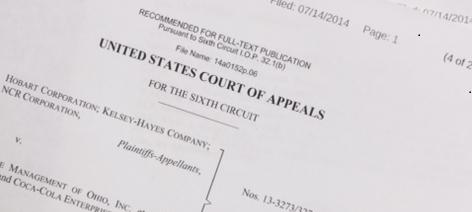Sixth Circuit Considers CERCLA “Twilight Zone” — Hobart Corp. v. Waste Management of Ohio
Sixth Circuit Considers CERCLA “Twilight Zone” — Hobart Corp. v. Waste Management of Ohio
- May 5, 2015
- By AngelaB
- Share this Article

“No one accuses CERCLA of being a well-drafted or easy-to-follow statute.” Hobart Corp. v. Waste Management of Ohio, Nos. 13-3273/3276 (6th Cir. 7/14/2014).
On July 14, 2014, the federal Sixth Circuit Court of Appeals held that where a party enters into an administrative settlement with EPA under CERCLA, that party is bound by the three-year statute of limitations applicable to contribution actions under CERCLA § 113(f)(3)(B), and may not rely on the more liberal limitations periods applicable to cost recovery claims under § 107(a). Key to the decision was the court’s analysis on the question whether a voluntary settlement with EPA constituted an “administrative settlement” for purposes of § 113 contribution. The decision provides valuable guidance for practitioners who navigate the perilous straits of CERCLA cost recovery strategy.
The decision involved liability for the costs of investigating environmental conditions at the defunct South Dayton Landfill site near Dayton, Ohio. The plaintiffs—private parties who were potentially liable for contamination at the site under CERCLA Section 107(a)—entered into an “Administrative Settlement Agreement and Order on Consent” (“ASAOC”) with U.S. EPA. Through the ASAOC, the plaintiffs agreed to pay EPA’s response costs and to conduct a site investigation. The purpose of the investigation was to determine the extent of site contamination and to identify cleanup alternatives. The ASAOC became effective August 15, 2006.
On May 24, 2010, the plaintiffs sued a group of defendants, seeking to have them pay a portion of the costs of the investigation and of the EPA costs. Among other things, the plaintiffs sought cost recovery and contribution under both CERCLA §§ 107(a) and 113(f)(3)(B). The U.S. District Court for the Southern District of Ohio threw out the CERCLA claims, reasoning:
- A party can seek either cost recovery under § 107(a) or contribution under § 113(f), but not both;
- The ASAOC was an administrative settlement under § 113(f)(3)(B);
- The applicable statute of limitations for § 113 contribution actions is three years from the effective date of the settlement, CERCLA § 113(g)(3)(B); and
- The plaintiffs’ CERCLA claims were time-barred because they were brought more than three years after the ASAOC went into effect.
On appeal, the Sixth Circuit acknowledged the tension between §107 cost recovery and §113(f) contribution:
Navigating the interplay between these sections is not easy. The best help that the [Supreme] Court has given us is to say that ‘costs incurred voluntarily are recoverable only by way of § 107(a)(4)(B), and costs of reimbursement to another person pursuant to a legal judgment or settlement are recoverable only under § 113(f).’
In the appellate court’s assessment, the appellants found themselves “in the twilight between a core § 107 cost-recovery action and a core § 113 contribution action,” since they directly paid for the site investigation, incurring an expense, but only because the ASAOC required them to do so. Under that situation, could the appellants choose which section of CERCLA under which to proceed, or were they constrained to a particular cause of action? The Sixth Circuit held the latter—if a party is able to bring a contribution action, it must do so under § 113(f), rather than 107(a).
The idea that § 107 and § 113(f) provide mutually exclusive claims is nothing new. The Sixth Circuit did, however, provide an insightful analysis of why the ASAOC was a “settlement agreement” subject to § 113 contribution rather than § 107 cost recovery. The court reasoned:
- Under § 113(f)(3)(B) and the Sixth Circuit’s prior precedent, the defining feature of an “administrative settlement” is that the agreement resolves the party’s liability to the federal government or a state for some or all of a CERCLA response action, or for some or all of the costs of such an action.
- In determining whether an agreement resolves such liability, the court interprets the agreement as a contract according to state-law principles. Under Ohio law, the key is the intent of the parties, as reflected in the language they chose to employ in the agreement.
- Numerous aspects of the ASAOC indicated that the parties intended for it to resolve the appellants’ liability to the government, rendering it an “administrative settlement.” Not the least of those aspects was the fact that the ASAOC explicitly stated, “The parties agree that this Settlement Agreement constitutes an administrative settlement for purposes of Section 113(f)(3)(B) of CERCLA . . .pursuant to which [Appellants] have . . . resolved their liability to the United States . . . .”
In the context of CERCLA, a statute not known to be “model of legislative draftsmanship,” Exxon v. Hunt, 475 U.S. 355, 363 (1986), Hobart v. Waste Management provides yet another map to help navigate the shoals of mutually-exclusive claims and conflicting statutes of limitations.
Chris Walker practices environmental law with Van Kley & Walker in Dayton, Ohio. Van Kley & Walker represented several defendants in Hobart v. Waste Management. You can contact Chris at cwalker@vankleywalker.com or his colleague Jack Van Kley at jvankley@vankleywalker.com.
- Post Categories
- Perspective
AngelaB
